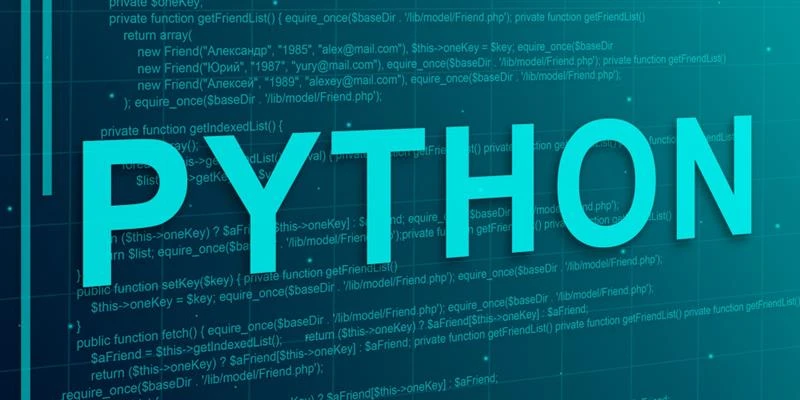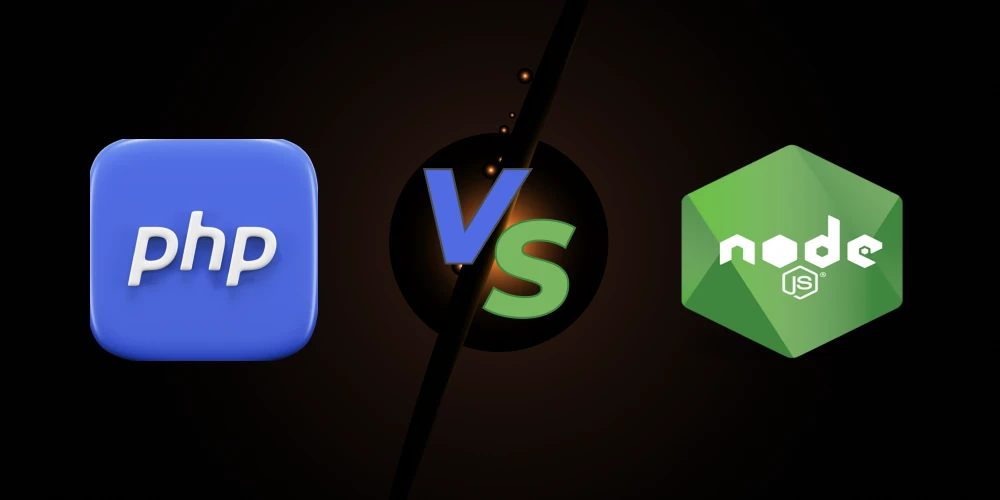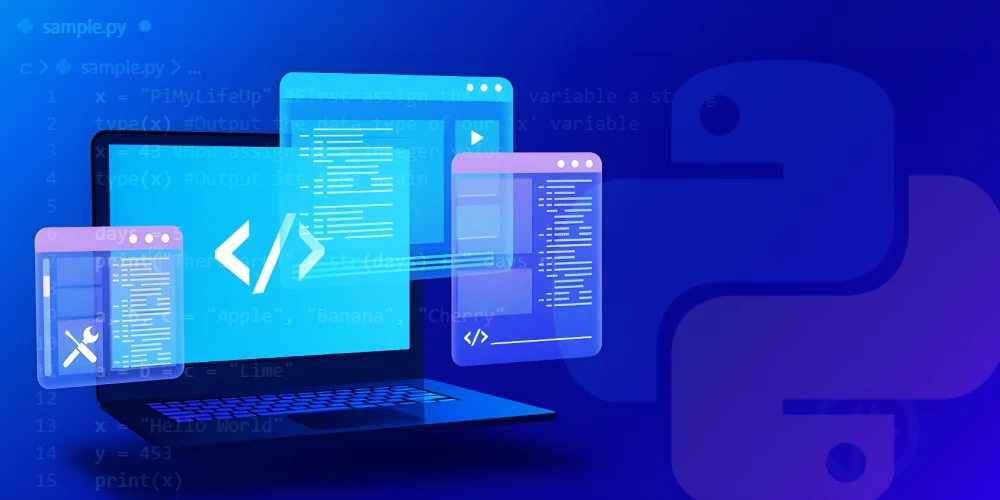Web development solutions are continuously evolving, and every other programming language has new with new updates. PHP and Python are the most popular programming languages for creating scalable web app solutions. However, there always seems to be a battle between choosing one as the winner.
In this blog, we discuss PHP vs Python in detail, comparing the key features and deciding who wins.
What is PHP?
Developed by Rasmus Lerdorf in 1994, PHP is an open-source scripting language that is used to develop dynamic and interactive websites. PHP was primarily developed as a tool to manage web pages; however, with its evolution, it turned into the most preferable choice for building web app development solutions.
PHP was known as ‘Personal Home Page’, but with time the acronym changed, and it now stands for ‘Hypertext Preprocessor’.
Key Features of PHP
The key features of PHP are server-side scripting, easy database integration, cross-platform compatibility, framework adaptability, and community support. Below is a brief discussion of each of them.
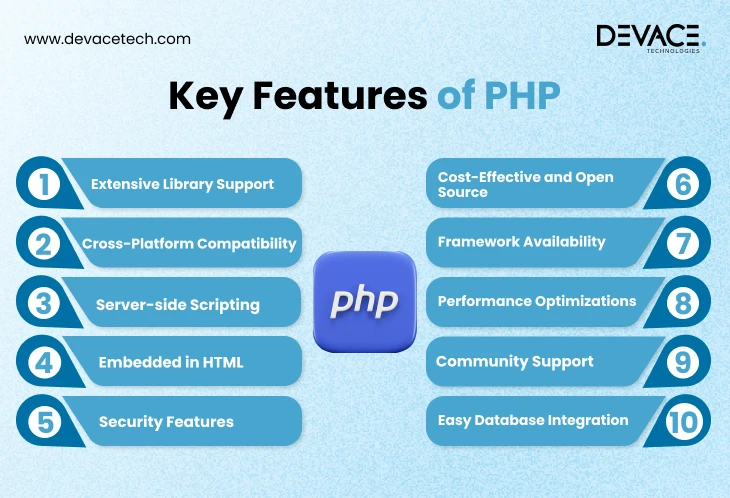
Below is a brief discussion of them.
Extensive Library Support
It provides extensive built-in libraries and extensions which are helpful in simplifying and streamlining development. By leveraging these libraries, developers have ready-to-use functions for handling everything from file operations, image processing, and encryption, to data handling, allowing developers to implement complex functionality without needing to write code from scratch.
The extensive library support from PHP accelerates the project development and also reduces potential errors. This feature makes it an ideal choice for not only experts but also for beginners to want to develop feature-rich applications effortlessly.
Server-side Scripting
The main benefit of PHP is that it first loads the database and information on the server before it is available for preview to the user. The server-side feature of PHP helps with faster loading times and a better user experience with a reduced bounce rate. By using this feature of PHP, users can develop fast, interactive, and dynamic websites by leveraging user input and interacting with databases.
Cross-Platform Compatibility
When developing a website, the most important factor is how well a website can run on different platforms or operating systems.
Well, this concern is resolved using PHP as it runs seamlessly across all the major operating systems such as Linux, Windows, macOS, and Unix. It ensures cross-platform computability i.e., your website can run in different environments with little to no code modification. In addition to that, combined with its support on many popular web servers like Apache and NGINX, PHP offers developers a high level of flexibility when it comes to deployment.
Embedded in HTML
Looking for simplified web development using PHP? Another top feature of using PHP is it can be embedded in HTML code that enables developers to mix the PHP code with HTML. It results in seamless integration of server-side functionality within web page templates.
PHP can be embedded directly into HTML code, allowing developers to mix PHP code with HTML for seamless integration. Developers do not need to be dependent on external files for server-side processing, making it faster and easier to build pages that respond to user input.
Security Features
With the growing cases of cyber thefts, security features within a programming language have become an essential need for confidentiality, integrity, and availability of data. Speaking of PHP, it comes with built-in functions and tools for developing secure web applications. Several security features to enlist are encryption functions, secure session handling, and input validation.
It must be noted that the previous versions of PHP faced criticism for not-so-good security. But the modern PHP offers robust security, and developers have access to best practices to avoid common vulnerabilities, such as SQL injection, cross-site scripting (XSS), and cross-site request forgery (CSRF).
Cost-Effective and Open Source
Open-source languages are the best to use. Why? They encourage a vibrant ecosystem of tools, PHP frameworks, and libraries. Beginners and experts can use it easily. In addition to that, businesses that use PHP experiences reduced costs associated with proprietary software licenses, making it popular among startups and enterprises looking to build scalable applications on a budget.
Framework Availability
Talk about streamlining web development and having PHP do it. It offers several popular frameworks like Laravel, Symfony, and CodeIgniter. These available frameworks simplify the web development as they have built-in tools for routing, templating, database management, and more. They follow the MVC (Model-View-Controller) pattern, which helps developers organize code better and speed up development, especially for larger applications.
Performance Optimizations
For any scalable website, it is essential to have an optimal performance so that it delivers a better user experience. PHP – with every update brings significant improvements in performance, especially with PHP 7 and newer versions, which introduced optimizations that make applications run faster.
These performance optimizations in each update reduce memory consumption by making it possible for applications to handle more requests per second as compared to the older versions.
If you are facing speed and performance optimization for your PHP web app, hire PHP developers to take your app performance to the next level.
Easy Database Integration
For any programming language, it is essential to have flexible integration with a variety of databases.
With PHP, you get flexible integration with a wide range of database systems such as MySQL, PostgreSQL, Oracle, and SQLite. This feature makes PHP ideal for developing database-driven applications such as CMS, eCommerce websites, and other applications that require data storage and retrieval.
Community Support
PHP has one of the most active and large communities worldwide which makes it easier to understand. Ranging from knowledgebase articles, extensive documentation, tutorials, open-source libraries, and frameworks, to plug-ins, PHP has something for everyone.
Whether you are a beginner who needs to understand basic functionalities or an expert facing a challenge, its community support will solve all the questions.
The PHP community also contributes to the language’s security by frequently identifying and patching vulnerabilities.
What is PHP Used For?
As it is a scripting language, it is primarily used for server-side scripting where it is embedded into HTML code to create dynamic and interactive web pages. A few of its use cases are as below:
- Content Management Systems (CMS) – PHP powers popular CMS platforms like WordPress, Joomla, and Drupal.
- E-commerce Websites – Platforms like Magento, WooCommerce, and OpenCart use PHP to handle online transactions and manage product catalogs.
- Web Applications – PHP is used for building custom web applications, from social media platforms to project management tools.
- Data-Driven Websites – PHP works well for creating applications that interact with databases, such as those that store and retrieve user-generated content.
- APIs and Web Services – It is also used to create APIs and handle data exchange between different services.
PHP’s flexibility, ease of use, and support for a variety of databases make it an ideal choice for developers creating dynamic websites and applications.
What is Python?
Python was first released in 1991 and developed by Guido van Rossum. It is a high-level and one of the fastest coding languages that is known for its readability, simplicity, and easy syntax that beginners can get started with easily
The applications of Python are quite wide-ranging from web development, data analysis, artificial intelligence, machine learning, and automation, to scientific computing. It provides an extensive standard library and community that provides a rich ecosystem of modules and frameworks, making it a popular choice for developers across various industries.
Its frameworks like Django, Flask, and Web2Py are used by developers for seamless web development.
Key Features of Python
The key features of Python include clean and concise syntax, cross-platform compatibility, built-in memory management, support for asynchronous programming, and adaptability for ML, AI, IoT, and big data.
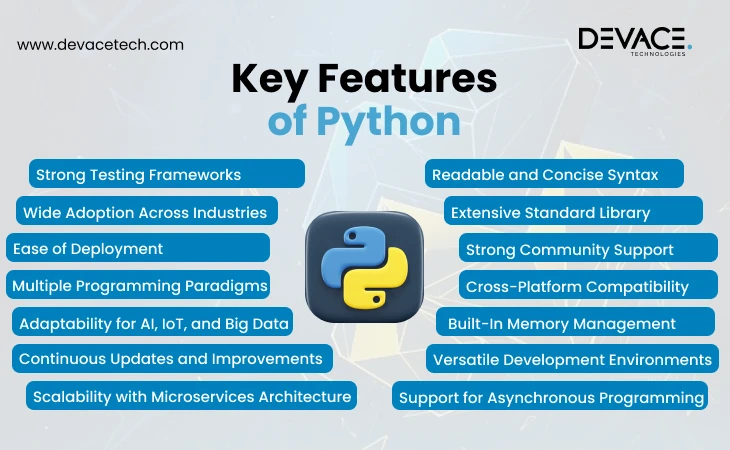
Let’s take a look at a few more features in detail.
Readable and Concise Syntax
One of the most prominent features of Python is that it has clean, concise, and readable code with an intuitive syntax that is similar to plain English. If we compare other frameworks, such as Python vs Java, Python is far more concise and readable. This simplicity makes it an excellent choice for beginners while allowing the pro developers to quickly understand and execute new codebases, making collaborative development smoother.
Extensive Standard Library
By using Python extensive standard library (modules and functions), you can execute a number of tasks such as file I/O, web development, data manipulation, and more. Developers do not need to go through external libraries because Python’s own is enriched.
In addition to that it has a vast ecosystem of libraries and frameworks for building web app solutions. Python’s popular libraries include NumPy and Pandas which are used for data science, and machine learning, Django and Flask for web development, and more.
Built-In Memory Management
Another top feature of Python is that it handles memory management automatically with an efficient garbage collector that frees up unused memory spaces and manages resources behind the scenes. It reduces developers’ overheads when working on handling complex data structures and allows for efficient code execution.
Support for Asynchronous Programming
Developers can write concurrent code using asyncio which makes it easier and plausible for the developers to handle multiple tasks at once. If a developer is working on creating a high-performance app such as web servers and real-time data processing. You can hire Python programmers to work on concurrent code and leverage their technical expertise for your project.
Ease of Deployment and Versatile Development Environments
The best thing about Python is that it adapts itself to the various development environments (which also makes it cross-platform compatible). Speaking of ease of deployment, tools like Docker and cloud platforms offer easy deployment options for Python applications, allowing developers to transition from development to production with minimal friction. Hence, time-saving and also reduces effort.
Scalability with Microservices Architecture
If you want to create scalable applications, then Python is the perfect programming language due to its microservices architecture. Frameworks such as Flask and FastAPI allow developers to break down large applications into smaller and independent services that they can scale depending on the individual needs of the customers.
Multiple Programming Paradigms (Object-Oriented, Functional, etc.)
Another key feature of Python is that it is ideal for automating tasks and scripting. Developers leverage Python to automate repetitive tasks such as file management, perform batch operations, and test websites. This saves time and developers can focus on core tasks, making it one of the most in-demand programming languages.
Strong Testing Python Frameworks
Testing frameworks of a programming language are essential as they ensure quality assurance of the web app being developed. The popular Python frameworks for testing such as Pytest, Unittest, and Nose, make it easier to write and maintain test cases. These frameworks help in automating testing, ensuring code reliability, and allowing for continuous integration and deployment.
Adaptability for AI, IoT, and Big Data
Gathering data from the above-mentioned points i.e., Python’s simplicity, extensive libraries, and compatibility with data-heavy tasks make it an ideal choice for emerging fields like artificial intelligence, the Internet of Things (IoT), and big data processing. Whether you want to prototype your product and deploy complex models or update an existing app to a complex one, then Python is the perfect choice.
Continuous Updates and Improvements
The continuous updates and improvements may be difficult to catch up with, but they are important for security purposes and optimizations. The Python Software Foundation and the language community consistently release updates related to new features, security patches, and optimizations. It shows the programming language is evolving and is a suitable choice for the current trends.
What is Python Used For?
Being a high-level programming language, it is widely used for various tasks such as web development, data science, machine learning, software development, and embedded systems. Below is a brief description of the Python use cases that answer why Python is so popular among SMBs and enterprises.
- Web Development: Frameworks like Django and Flask allow for rapid, secure web development.
- Data Science and Machine Learning: Python is popular in data science, machine learning, and artificial intelligence, thanks to libraries like NumPy, Pandas, SciPy, TensorFlow, and Scikit-Learn.
- Automation and Scripting: Python is often used for automating repetitive tasks, including system administration, data scraping, and testing.
- Software Development: Python supports general-purpose programming for building desktop applications and even game development with libraries like Pygame.
- Embedded Systems: With MicroPython, Python can be used in small, embedded devices like microcontrollers.
Python’s flexibility, coupled with an active community, makes it a preferred language for developers across industries.
PHP vs Python: Detailed Comparison in a Table
After a detailed discussion of both programming languages i.e., PHP and Python, here is a comparison in a table to have an aerial overview of both.
| Aspect | PHP | Python |
|---|---|---|
| Purpose | Primarily built for web development; great for server-side scripting | General-purpose language; popular for web, AI, data science, automation, and more |
| Syntax | Slightly complex, with lots of dollar signs and other symbols | Simple and clean syntax; highly readable and beginner-friendly |
| Ease of Learning | Moderate to learn; great for those familiar with C-style syntax | Easy to learn; often recommended as a first programming language |
| Performance | Fast for web applications due to its synchronous nature | Generally slower than PHP for web, but offers solutions like AsyncIO for better speed |
| Frameworks | Popular ones include Laravel, CodeIgniter, Symfony | Django and Flask are popular; Django particularly for its “batteries included” approach |
| Community Support | Strong community support; lots of resources for web development | Equally large community; broad support across multiple fields |
| Error Handling | Basic error handling, but less intuitive debugging compared to Python | Python’s error handling is more intuitive, with clearer tracebacks and debugging tools |
| Versatility | Primarily used for web apps; limited outside the web domain | Extremely versatile; used in web, machine learning, data analysis, and more |
| Package Management | Relies on Composer for package management | Uses pip, a straightforward and highly efficient package manager |
| Hosting & Deployment | Easily supported by most web hosting providers; runs well on shared hosting | Not as widely supported on shared hosting; more commonly deployed on cloud or VPS |
| Scalability | Scalable in web contexts, especially with frameworks like Laravel | Highly scalable for various applications; well-suited for microservices architecture |
| Database Integration | Great for MySQL and works well with other relational databases | Supports both relational (MySQL, PostgreSQL) and non-relational databases |
| Best Use Cases | Dynamic web pages, content management systems, e-commerce platforms | Data science, machine learning, automation, web apps, and desktop applications |
| Popularity in Web Dev | Still one of the most popular choices for web, especially for content-heavy sites | Growing rapidly for web, especially for data-intensive and high-performance applications |
| Job Market | Strong demand, particularly for web development roles | High demand across multiple fields, from web to AI and data science |
PHP vs Python: Know the Similarities
Here’s a detailed comparison table between PHP and Python, focusing on their similarities. Both languages are popular, versatile, and widely used in web development, scripting, and beyond.
| Aspect | PHP | Python |
|---|---|---|
| General Purpose | Server-side scripting language primarily used for web development. | The general-purpose programming language used for web, scripting, and various other applications. |
| Open Source | Open-source and widely supported. | Open source with a large community of developers. |
| Cross-platform Support | Works on major operating systems (Windows, macOS, Linux). | Works on major operating systems (Windows, macOS, Linux). |
| Web Development | Excellent for server-side web development, used in CMS like WordPress. | Used for web development via frameworks like Django and Flask. |
| Simplicity | Easy to learn for beginners, especially for web-based projects. | Known for its readability and simplicity, making it great for beginners. |
| Dynamic Typing | Dynamically typed, with strong support for handling web forms and inputs. | Dynamically typed, making it flexible and concise for all types of applications. |
| Popular Frameworks | Laravel, Symfony, CodeIgniter, Zend. | Django, Flask, Pyramid. |
| Integration with Databases | Excellent for database-driven applications like MySQL and PostgreSQL. | Excellent for database integration with MySQL, PostgreSQL, SQLite, and more. |
| Community Support | Large and active community, with tons of libraries and frameworks. | Large, active community providing rich libraries and frameworks for various uses. |
| Web Scraping | Can be used for web scraping through third-party libraries. | Extremely popular for web scraping with libraries like BeautifulSoup and Scrapy. |
| APIs and Web Services | Excellent support for building RESTful APIs and web services. | Strong support for building REST APIs using frameworks like Flask and Django. |
| Object-Oriented Programming | Supports object-oriented programming, though it’s not as enforced as Python. | Strong emphasis on object-oriented programming (OOP). |
| Server-Side Scripting | Predominantly used for server-side scripting in web development. | Can be used for server-side scripting, although less common in web servers than PHP. |
Both PHP and Python share several similarities, especially in their ability to handle web development tasks, work across platforms, and integrate with databases. Python is known for its broader applications across fields like data science, AI, and automation, while PHP heavily focuses on web-centric tasks, making both languages versatile in their respective domains.
PHP vs Python: Who is the Winner?
In the detailed analysis of Python vs PHP, Python is a top choice when it comes to web development as compared to PHP. However, it entirely depends upon project requirements. So, here is what we can say:
- Choose PHP if your focus is on web development—especially if you’re working with content-heavy sites, e-commerce platforms, or CMS-based projects. PHP is optimized for server-side scripting and comes with many ready-to-use frameworks like Laravel and WordPress that make it ideal for building websites quickly.
- Choose Python if you need a versatile language that can support data analysis, machine learning, and cross-functional applications beyond web development. Python’s syntax is beginner-friendly and has powerful libraries for data science, making it a top choice for projects involving AI, data processing, or rapid development.
Hire Remote Developers From Devace Technologies
Whether it is PHP, Python, or any other technology, we provide remote developers to work on your project and scale it seamlessly. Choose from our engagement models, book a call, and hire the right developer for your project.
Frequently Asked Questions
Which language is better, PHP or Python?
The best language depends on your project’s needs. PHP is a go-to for web-specific tasks with built-in web development functionalities, while Python is more versatile, supporting web development as well as data science, AI, and machine learning.
Is PHP faster than Python?
In PHP vs Python speed, PHP is faster for web tasks, being optimized for server-side scripting. However, Python performs well with data-heavy applications, and recent optimizations in both languages have made their speed differences less noticeable.
What can Python do that PHP can’t?
Python supports advanced data science, AI, and machine learning projects through its extensive libraries, which PHP lacks. This makes Python ideal for applications requiring complex data processing, which is challenging to achieve with PHP alone.
Is Python replacing PHP?
Python’s popularity is growing, especially in areas like AI and modern software, but PHP still dominates in content-driven and traditional server-side applications, especially on platforms like WordPress.
Which language is more secure, Python or PHP?
Security depends largely on usage. PHP has improved security, particularly with frameworks like Laravel, but it’s also vulnerable to errors if poorly implemented. Python’s readability aids security, and often choose for high-security applications.
Why do some large companies avoid PHP?
Large companies often favor Python for projects needing heavy data processing or real-time performance, as it’s more versatile and suitable for AI. PHP is still used but is less common for high-performance, complex applications.

